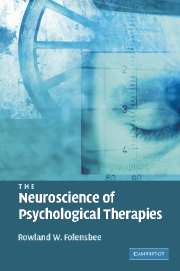Book contents
- Frontmatter
- Contents
- Acknowledgements
- 1 Introduction
- Part 1 Basic concepts
- Part 2 The process of psychotherapy
- 10 Introduction to neuroscience applications in psychotherapy
- 11 Intake and assessment
- 12 Neural networks in therapy
- 13 Affect in therapy
- 14 Memory and change
- 15 Anxiety and change
- 16 The experience of improvement in psychotherapy
- 17 The therapist's neuroscience
- 18 Communicating with clients through neuroscience
- 19 Integrating traditional therapies
- 20 Applying neuroscience to depression intervention
- 21 Neuroscience and psychotherapy: moving forward
- Appendix: Neuroimaging and psychological therapies
- References
- Index
16 - The experience of improvement in psychotherapy
Published online by Cambridge University Press: 15 December 2009
- Frontmatter
- Contents
- Acknowledgements
- 1 Introduction
- Part 1 Basic concepts
- Part 2 The process of psychotherapy
- 10 Introduction to neuroscience applications in psychotherapy
- 11 Intake and assessment
- 12 Neural networks in therapy
- 13 Affect in therapy
- 14 Memory and change
- 15 Anxiety and change
- 16 The experience of improvement in psychotherapy
- 17 The therapist's neuroscience
- 18 Communicating with clients through neuroscience
- 19 Integrating traditional therapies
- 20 Applying neuroscience to depression intervention
- 21 Neuroscience and psychotherapy: moving forward
- Appendix: Neuroimaging and psychological therapies
- References
- Index
Summary
Anxiety often offers the initial signal that neural networks are operating in unrecognized ways to disrupt the client's functioning. Anxiety often then guides the exploration of the network. In the case of anxiety related to the novelty intrinsic to psychological change, anxiety then signals the shift from processing past learning to creating a new future.
The next step implied by the description of novelty, anxiety, and The Empty Head is the facilitation of new neural connections in new, adaptive neural networks. Throughout discussion of neural networks and the activation of maladaptive functioning the importance of connecting adaptive networks to maladaptive ones has been emphasized. This process provides the basis for developing adaptive behaviors for the future. As the client confronts the sense of feeling lost that often accompanies change, networks associated with a history in therapy of confronting distress with the support of the therapist should be available to be activated. Such patterns compete with the sense of being lost and disoriented, reducing the intensity of such feelings. The client's relationship with the therapist accompanied by experiences of successfully coping with distress within the context of therapy can offer initial new networks with which to fill The Empty Head.
At this point in therapy the client needs to begin to develop neural patterns associated with positive coping, and these patterns need to be firmly connected to stimuli that previously triggered strong negative emotions, anxiety, and defensive behaviors that previously undermined successful adaptation to life.
- Type
- Chapter
- Information
- The Neuroscience of Psychological Therapies , pp. 133 - 136Publisher: Cambridge University PressPrint publication year: 2007



